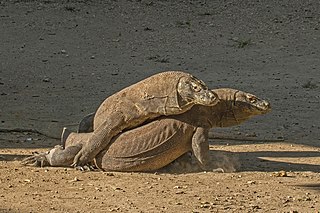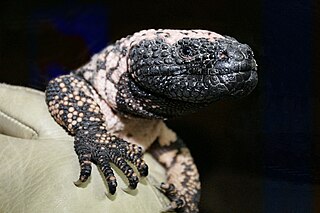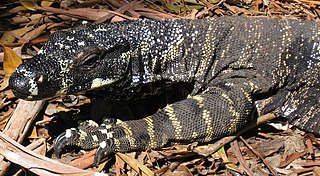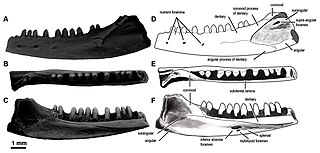
Lizards are a widespread group of squamate reptiles, with over 7,000 species, ranging across all continents except Antarctica, as well as most oceanic island chains. The group is paraphyletic since it excludes the snakes and Amphisbaenia, and some lizards are more closely related to these two excluded groups than they are to other lizards. Lizards range in size from chameleons and geckos a few centimeters long to the 3-meter-long Komodo dragon.

The Lepidosauria is a subclass or superorder of reptiles, containing the orders Squamata and Rhynchocephalia. Squamata includes snakes, lizards, and amphisbaenians. Squamata contains over 9,000 species, making it by far the most species-rich and diverse order of non-avian reptiles in the present day. Rhynchocephalia was a formerly widespread and diverse group of reptiles in the Mesozoic Era. However, it is represented by only one living species: the tuatara, a superficially lizard-like reptile native to New Zealand.

Squamata is the largest order of reptiles, comprising lizards, snakes, and amphisbaenians, which are collectively known as squamates or scaled reptiles. With over 11,500 species, it is also the second-largest order of extant (living) vertebrates, after the perciform fish. Members of the order are distinguished by their skins, which bear horny scales or shields, and must periodically engage in molting. They also possess movable quadrate bones, making possible movement of the upper jaw relative to the neurocranium. This is particularly visible in snakes, which are able to open their mouths very wide to accommodate comparatively large prey. Squamates are the most variably sized living reptiles, ranging from the 16 mm (0.63 in) dwarf gecko to the 6.5 m (21 ft) reticulated python. The now-extinct mosasaurs reached lengths over 14 m (46 ft).

The Varanidae are a family of lizards in the superfamily Varanoidea and order Anguimorpha. The family, a group of carnivorous and frugivorous lizards, includes the living genus Varanus and a number of extinct genera more closely related to Varanus than to the earless monitor lizard (Lanthanotus). Varanus includes the Komodo dragon, crocodile monitor, savannah monitor, the goannas of Australia and Southeast Asia, and various other species with a similarly distinctive appearance. Their closest living relatives are the earless monitor lizard and chinese crocodile lizard. The oldest members of the family are known from the Late Cretaceous of Mongolia.

The earless monitor lizard is a semiaquatic, brown lizard native to the Southeast Asian island of Borneo. It is the only living species in the family Lanthanotidae and it is related to the true monitor lizards.

Heloderma is a genus of toxicoferan lizards that contains five species, all of which are venomous. It is the only extant genus of the family Helodermatidae.

The Mexican beaded lizard is a species of lizard in the family Helodermatidae, one of the two species of venomous beaded lizards found principally in Mexico and southern Guatemala. It and the other members of the same genus, including the Gila monster, are the only lizards known to have evolved an overt venom delivery system. The Mexican beaded lizard is larger than the Gila monster, with duller coloration, black with yellowish bands. As it is a specialized predator that feeds primarily upon eggs, the primary use of its venom is still a source of debate among scientists. This venom has been found to contain several enzymes useful for manufacturing drugs in the treatment of diabetes, and research on the pharmacological use of its venom is ongoing.

Toxicofera is a proposed clade of scaled reptiles (squamates) that includes the Serpentes (snakes), Anguimorpha and Iguania. Toxicofera contains about 4,600 species, of extant Squamata. It encompasses all venomous reptile species, as well as numerous related non-venomous species. There is little morphological evidence to support this grouping; however, it has been recovered by all molecular analyses as of 2012.

Varanoidea is a superfamily of lizards, including the well-known family Varanidae. Also included in the Varanoidea are the Lanthanotidae, and the extinct Palaeovaranidae.

The Anguimorpha is a suborder of squamates. The group was named by Fürbringer in 1900 to include all autarchoglossans closer to Varanus and Anguis than Scincus. These lizards, along with iguanians and snakes, constitute the proposed "venom clade" Toxicofera of all venomous reptiles.

The Gila monster is a species of venomous lizard native to the Southwestern United States and the northwestern Mexican state of Sonora. It is a heavy, slow-moving reptile, up to 56 centimetres (22 in) long, and it is the only venomous lizard native to the United States. Its venomous close relatives, the four beaded lizards inhabit Mexico and Guatemala. The Gila monster is sluggish in nature, so it is not generally dangerous and very rarely poses a real threat to humans. However, it has a fearsome reputation and is sometimes killed in spite of the species being protected by state law in Arizona.

The Guatemalan beaded lizard, also called commonly the Motagua Valley beaded lizard, is a highly endangered species of beaded lizard, a venomous lizard in the family Helodermatidae. The species is endemic to the dry forests of the Motagua Valley in southeastern Guatemala, an ecoregion known as the Motagua Valley thornscrub. It is the only allopatric beaded lizard species, separated from the nearest population by 250 km (160 mi) of unsuitable habitat. The Guatemalan beaded lizard is the rarest and most endangered species of beaded lizard, and it is believed that fewer than 200 individuals of this animal exist in the wild, making it one of the most endangered lizards in the world. In 2007, it was transferred from Appendix II to Appendix I of CITES due to its critical conservation status.

Platynota is a polyphyletic group of anguimorph lizards and thus belongs to the order Squamata of the class Reptilia. Since it was named in 1839, it has included several groups, including monitor lizards, snakes, mosasaurs, and helodermatids. Its taxonomic use still varies, as it is sometimes considered equivalent to the group Varanoidea and other times viewed as a distinct group. It is phylogenetically defined as a clade containing Varanidae. It also includes many extinct species.

Femoral pores are a part of a holocrine secretory gland found on the inside of the thighs of certain lizards and amphisbaenians which releases pheromones to attract mates or mark territory. In certain species only the male has these pores and in other species, both sexes have them, with the male's being larger. Femoral pores appear as a series of pits or holes within a row of scales on the ventral portion of the animal's thigh.

Glyptosaurinae is an extinct subfamily of anguid lizards that lived in the Northern Hemisphere during the Late Cretaceous and the Paleogene.
Pyrenasaurus is an extinct genus of lizard that includes only one species, the type species Pyrenasaurus evansae, which lived around the Pyrenees mountains during the Late Eocene. P. evansae was named in 2014 on the basis of three dentaries, one from the Phosphorites du Quercy in Quercy, France and two from the Sossís fossil locality in Catalonia, Spain. The paucity of known material makes its relationships uncertain; it is either a true skink in the family Scincidae or a close relative of skinks in the larger group Scincoidea. Pyrenasaurus is very small for a lizard, with a dentary length of only 3.4 millimetres (0.13 in). It also has very few teeth for a lizard, with only eleven tooth positions in the dentary. Other unusual anatomical features include the shortness straightness of the jaw, the lack of a Meckelian groove on the inside of the dentary, and the enlargement and lateral compression of the posterior-most dentary teeth. Pyrenasaurus may have been a fossorial or burrowing lizard because a short, straight dentary with few teeth is also present in numerous living fossorial lizards, having evolved independently in many lineages. However, the extremely small size of Pyrenasaurus may have inhibited its ability to burrow. The enlarged posterior teeth of Pyrenasaurus suggest it had a specialized diet, but what it was eating remains unknown because no living lizards have similar dentitions.
Pelsochamops is an extinct genus of Chamopsiid lizard, containing the single species P. infrequens from the Santonian aged Csehbánya Formation of Hungary, known from a partial dentary and maxilla fragments. It is the first chamopsiid known from Europe, the rest being known from North America.

The Rio Fuerte beaded lizard is a venomous species of beaded lizard in the family Helodermatidae. It is found in the tropical forests and shrublands of western Mexico, specifically around the Rio Fuerte and Rio Mayo basins. It is often found in or near abandoned mammal burrows and sources of water.

Sciroseps is an extinct genus of scincomorph squamates known from a partial left mandible, UA-2016-13-294, from the Early Cretaceous (Albian) Holly Creek Formation of the Trinity Group in Arkansas, USA. The type and only species is Sciroseps pawhuskai. Its generic name is derived from Greek "σκυρος: skiros" (gypsum), and "σεπος: sepos" ; and its species name refers to historic Osage chief Pawhuska.
Heloderma alvarezi, the Chiapan beaded lizard or black beaded lizard, is a species of lizard of the Helodermatidae family. It is found in Mexico and Guatemala.


















